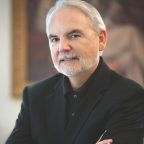On each episode of American Rhapsody, we interview those who have witnessed American history firsthand: politicians, reporters, photographers, and activists—all of whom have since donated their personal or professional archives to the Briscoe Center. We also interview historians, filmmakers, and other researchers who work in the center’s collections. These collections are the evidence of the past. Without them, there is no history, only myth. Each week we ask: what actually happened? The sum of all those answers in an American Rhapsody.
Hosts
 Don CarletonFounding Director of The University of Texas at Austin's Dolph Briscoe Center for American History
Don CarletonFounding Director of The University of Texas at Austin's Dolph Briscoe Center for American History
[0:00:00 Speaker 0]
[0:00:07 Don Carleton] This is American Rhapsody, a podcast of UT Austin’s Briscoe Center for American History.
[0:00:22 Don Carleton] Over the next few weeks, we’ll be hearing from a variety of people who have witnessed American history firsthand. They saw it, heard it, recorded it, and they wrote it down. They’ve taken notes and photographs, kept letters and receipts, preserved their memorabilia and their cassette tapes over many years, and garages and attics and storage units. They’ve amassed the raw materials historians rely on the evidence of the past, and now they’ve entrusted it to the Briscoe Center. You’ll also hear from historians, journalists and other researchers who mind the Briscoe centers, collections, those raw materials of the past, all that evidence of history in order to find out what actually happened. I’m Don Carleton. I’m a historian and the executive director of the Briscoe Center. Each week we’ll talk to people trying to answer that question. The sum of all those answers is an American rhapsody. If you pick up a dictionary or, more likely Google the Word Rhapsody, you’ll get a variety of answers and Greek. It means something like stitched song. Today, a rhapsody might mean an epic poem or an extravagant speech. Musically, a Rhapsody is an irregular composition in one movement, whether bohemian or blue, A Rhapsody is full of twists and terms, quirks and improvisations just like this one. Gershwin’s Rhapsody in Blue is quintessentialy American. It was formative and developing my cultural awareness as a child, my parents owned an old 78 rpm recording of the Rhapsody by the Paul Whiteman Orchestra that I fell in love with when I was very young. The Briscoe Center preserves several versions among its 90,000 commercial music recordings. This one is from 1924 and also features White Mons Orchestra. Rhapsody in Blue combines low and high brow culture, nostalgia and youthful energy, but somehow it still manages to form a coherent ho. There are a lot of metaphors for history, and Rhapsody is the one we’ve chosen to get to the heart of what this podcast is about. American history is many things, but it is most certainly a rhapsody, quilted together from the ragged patches of many disjointed stories and yet somehow still managing to form a coherent ho a t least we hope it does. Today. America is tourney by political and cultural upheaval as a result in understanding of this nation’s history, is being contested to an extent, rarely singing before. It isn’t just statues, they’re coming down. Whole schools of thought are under scrutiny, many of them rightly so. This is where the Briscoe Center, its collections and its projects enter the conversation. We house the raw materials of the past, the evidence of history we collected, preserve it and make it available. Miles of it, In fact, over 17 miles The last time we measured, we’re talking about the papers of politicians, the negatives and prints of photographers, the plantation Ledger books with lists of the names of the enslaved, the correspondence of social reform activists, documents from the women’s suffrage movement, the business records of music venues, unique mounts, clothing, even musical recordings like this one. People from across America have entrusted this evidence to us, and it is used by people from across America. In addition to inspiring their work, it inspires our own books, documentaries, exhibits, online repositories and digital humanities projects. Without this evidence, there is no history in the hard conversations we need to have his Americans conversations about our identities, values and origins lose focus. Without this evidence, we stray away from fax and into myth. Making the rhapsody becomes noise by collecting, preserving and making available these materials. We help keep the debates and arguments about who we are rooted in evidence. And we keep the American rhapsody going. Irregular, improvised, episodic and often disjointed, but ultimately one movement